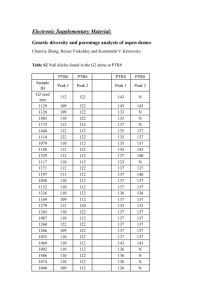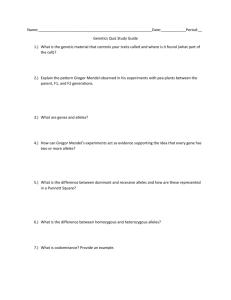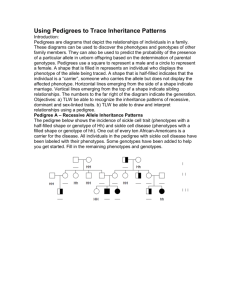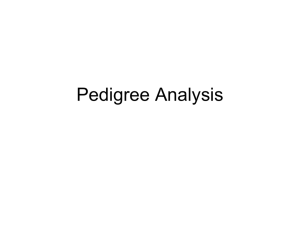Hw1
advertisement
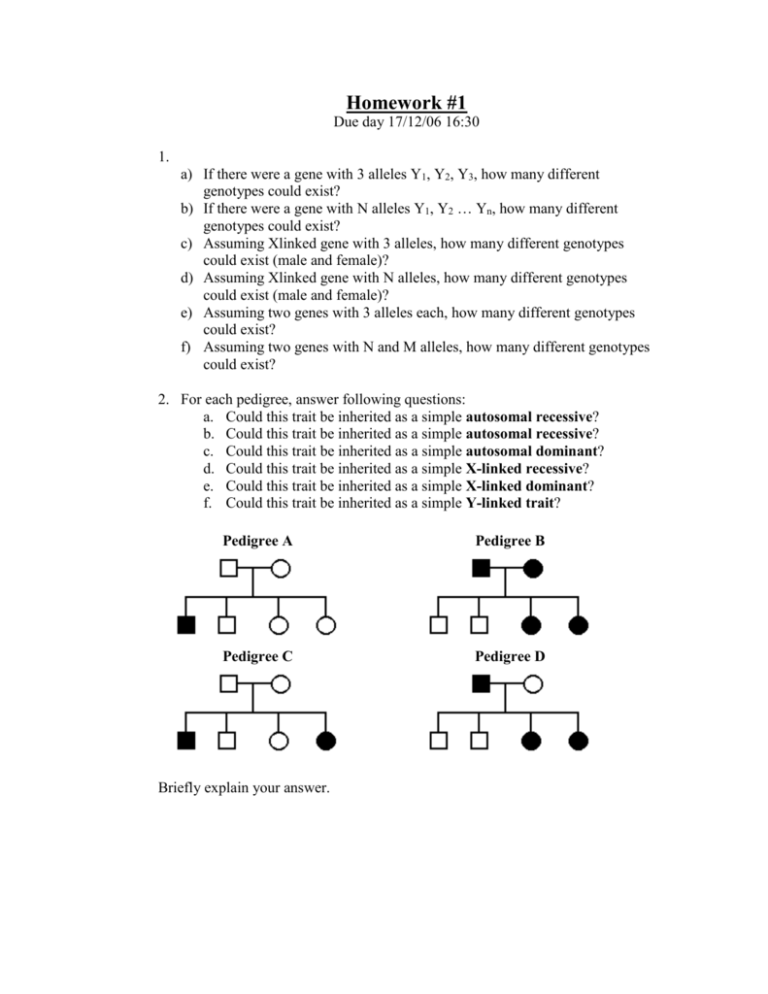
Homework #1 Due day 17/12/06 16:30 1. a) If there were a gene with 3 alleles Y1, Y2, Y3, how many different genotypes could exist? b) If there were a gene with N alleles Y1, Y2 … Yn, how many different genotypes could exist? c) Assuming Xlinked gene with 3 alleles, how many different genotypes could exist (male and female)? d) Assuming Xlinked gene with N alleles, how many different genotypes could exist (male and female)? e) Assuming two genes with 3 alleles each, how many different genotypes could exist? f) Assuming two genes with N and M alleles, how many different genotypes could exist? 2. For each pedigree, answer following questions: a. Could this trait be inherited as a simple autosomal recessive? b. Could this trait be inherited as a simple autosomal recessive? c. Could this trait be inherited as a simple autosomal dominant? d. Could this trait be inherited as a simple X-linked recessive? e. Could this trait be inherited as a simple X-linked dominant? f. Could this trait be inherited as a simple Y-linked trait? Pedigree A Pedigree B Pedigree C Pedigree D Briefly explain your answer. 3. For next pedigree determinate the inheritance mode (autosomal/xlinked, recessive/dominant) and write the genotypes in every possible place. If only one allele is known, put “_” instead of second allele. Assume, that none of the people that married into the family are carry the gene. 4. Htfoot (h), obese (o), and waved (wa) are recessive genes found in mice. A trihybrid whose parents were unknown was testcrossed, producing the following progeny: hotfoot, obese, waved hotfoot, obese waved obese wild-type hotfoot, waved obese, waved hotfoot TOTAL 361 74 66 74 348 57 11 9 1000 What is the order along the chromosome of any linked gene loci? How do you know? Draw the chromosomes with their associated alleles as they existed in the trihybrid. Determinate recombination values. 5. Cystic fibrosis is a genetic disorder in homozygous recessives that causes death during the teenage years. If 4 in 10,000 newborn babies have the disease, what are the expected frequencies of the three genotypes in newborns, assuming the population is at Hardy- Weinberg equilibrium? Why is this assumption not strictly correct? 6. Below are the genotypic frequencies for two genes in a natural population. Answer the following questions. GENOTYPE A1A1B1B1 A1A1B1B2 A1A1B2B2 A1A2B1B1 A1A2B1B2 A1A2B2B2 A2A2B1B1 A2A2B1B2 A2A2B2B2 TOTAL FREQUENCY 13 92 173 22 164 313 9 73 141 1,000 a. Are the loci in Hardy-Weinberg equilibrium? b. The numbers of observed chromosome types are A1B1 = 304, A1B2 = 751, A2B1 = 113, A2B2 = 832 (assume a chromosome type is the same as a gamete type). Are these genes in linkage equilibrium? 7. Maximum likelihood estimation. In the situations below, derive the maximum likelihood estimators of the parameters. Maximum likelihood estimation will be discussed in class. 1. What is the maximum likelihood estimate of p when you record one observation from a Binomial(n,p) distribution? That is, X is distributed as Binomial(n,p). You observe X=x. What is your estimate of p? 2. What is the maximum likelihood estimate of p when you record n independent observations from a Geometric(p) distribution? That is, X1, X2, ..., Xn are independent and distributed as Geometric(p) random variables. You observe X1=x1, X2=x2, ..., Xn=xn. What is your estimate of p? 3. What is the maximum likelihood estimate of mu when you record n independent observations from a Normal(mu, 52) distribution? That is, X1, X2, ..., Xn are independent and distributed as Normal(mu, 25) random variables. You observe X1=x1, X2=x2, ..., Xn=xn. What is your estimate of mu? 8. The mother of a family of 10 children has blood type Rh+. She also has a very rare condition, elliptocytosis, with no adverse clinical effect, in which the red blood cells are oval rather than round. The father is Rh- and has normal red cells. Their children include 1 Rh+ child with normal blood cells, 4 Rh+ children with oval blood cells, and 5 Rh- children with normal blood cells. These traits are determined by genes at two different autosomal loci. The allele for elliptocytosis (E) is dominant to the allele for normal cells (e). The allele for the Rh+ phenotype (h+) is dominant to that for Rh- (h-). a) What are the genotypes of the parents? b) What are the genotypes of each of the 3 phenotypic classes amongst their children? c) Could the elliptocytosis and Rh loci be on the same chromosome? If so, estimate the map distance between them. d) Suppose, for the sake of argument that the parents of the mother (maternal grandparents of the 10 children) were both homozygous at both loci. What would their genotypes have been? (In fact, since elliptocytosis is very rare, this scenario is unlikely.) 9. In Drosophila, an X-linked recessive mutation, scalloped (sd) causes irregular wing margins. Diagram the F1 and F2 results if: 1. A scalloped female is crossed with a normal male. 2. A scalloped male is crossed with a normal (homozygous) female. 3. Compare the results in a & b to those that would be observed if the scalloped gene were autosomal. Assume that the P1 individuals are homozygous. 10. Question from the tutorial: An organisms has 2 alleles (A,B). The population is exposed to a high temperature which proves to be lethal for all individuals homozygous for the A allele. Given that the population is maintained at this higher temperature, does A and B frequencies are stable? If not explain? If yes, after how many generations?

